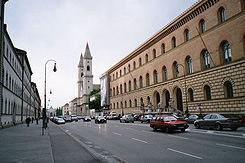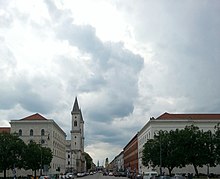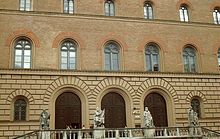Ludwigstrasse
| Ludwigstrasse | |
|---|---|
| Street in Munich | |
| Ludwigstrasse with the Bavarian State Library and St. Ludwig | |
| Basic data | |
| place | Munich |
| Borough | Maxvorstadt |
| Created | circa 1830 |
| Connecting roads | Odeonsplatz , Leopoldstrasse |
| Cross streets | Galeriestrasse, Oskar-von Miller-Ring ( Altstadtring ), Von-der-Tann-Strasse (Altstadtring), Rheinsbergerstrasse, Schönfeldstrasse, Theresienstrasse, Walter-Klingenbeck-Weg, Schellingstrasse , Veterinärstrasse, Adalbertstrasse , Akademiestrasse, Schackstrasse |
| Places | Geschwister-Scholl-Platz , Professor-Huber-Platz |
| use | |
| User groups | Pedestrian traffic , bicycle traffic , individual traffic , public transport |
| Technical specifications | |
| Street length | 1.0 km |
The Ludwig Street is next to the Briennerstraße , the Maximilianstrasse and the Prinzregentenstraße one of the four major urban boulevards of the Bavarian state capital Munich . The architectural style reflects the preference of the builder King Ludwig I for Italy and shows elements of the Italian Neo-Renaissance and Neo- Romanesque .
Location and course

Ludwigstrasse begins at Odeonsplatz and runs absolutely straight in a north-easterly direction, roughly parallel to the Isar . It crosses the Altstadtring (Oskar-von-Miller-Ring / Von-der-Tann-Straße), widens towards the end to a square square ( Geschwister-Scholl-Platz / Professor-Huber-Platz) that is part of the university buildings is enclosed until it ends at the Victory Gate. From there, its extension is called Leopoldstrasse .
Although Ludwigstrasse officially only begins north of Odeonsplatz, it forms an architectural and overall planning unit together with Odeonsplatz. The length of this unit from the Feldherrnhalle to the Siegestor is 1 km.
The Highlight Towers , which were completed in 2004, are directly in this line of sight; So you can z. B. can be seen from Odeonsplatz.
history
Royal time
The history of Ludwigstrasse begins in 1808 with an urban development competition for the northern urban expansion, today's Maxvorstadt . From the first planning on, the central road was given by the existing road to Freising , which was to be expanded. In the first part of his general plan for the city of Munich, the Hofgarten director Friedrich Ludwig von Sckell planned to plant four rows of avenues in 1811, but this was not carried out. Soon Crown Prince Ludwig , who later became King Ludwig I, got involved in the planning. In 1816 he commissioned his architect Leo von Klenze with the overall planning, which was replaced by Friedrich von Gärtner in 1827 . The goal was a street that represents the pillars of his kingdom restored by him: science and art, Roman Catholic Christianity and the royal government. The Ludwigstraße therefore had a double bracket: Feldherrnhalle and Siegestor are the beginning and end of the street, the music college, the Odeon on Odeonsplatz and the main building of the Ludwig Maximilians University (at that time the only building of the LMU) shortly before the Siegestor the other bracket that support the military.
Ludwigstrasse is the first street in which the architectural style specially developed for Ludwig I, the round arch style , was fully implemented. The southern part designed by Klenze shows features of the neo-renaissance , while the northern part of Gärtner's is more towards the neo- Romanesque.
Nazi era
The first important changes were made in the Third Reich : The block north of Galeriestraße / Hofgarten was demolished for the new building of the NSDAP Gauleitung (now the Bavarian State Ministry for Food, Agriculture and Forests ). This interrupts the flowing transition from the lower buildings in the historic old town to the more monumental buildings from around the level of Schellingstrasse . The situation is similar with the new building for the Reichsbank (at the level of Von-der-Tann-Strasse) and the House of German Law by Hans Frank 1936–1939 at the Siegestor. The new building of the Reichsbank (today Bundesbank-Bayern) was built in place of the Herzog-Max-Palais , Klenze's most beautiful palace building. This was demolished in 1936 by order of Hitler. The new building was only completed after the end of the war. During the Second World War , Ludwigstrasse was severely damaged in 1944/1945 by bombing and artillery fire and in 1945 by street fighting; it has not yet been restored in every detail.
After 1945
In the 1960s and 1970s, the breakthrough for the Altstadtring (Oskar-von-Miller-Ring / Von-der-Tann-Straße) came with the demolition of two historic houses and some facade renovations and gutting as part of the urban redevelopment project .
In the spring of 2019, the implementation of a city concept began to aesthetically redesign the interface between Ludwigstrasse and Leopoldstrasse, adding a house-high poplar avenue from the Siegestor to the head buildings at the university as a continuation of the tree-lined boulevard on Leopoldstrasse and also the appearance of the northern one Ludwigstrasse should determine. Since this changes the historical, purely stone appearance of Ludwigstrasse with its consistently wall-like character, the distance between the trees was chosen so that the facades behind them will still be visible.
Function for parties and parades

Traditionally, (state) parades are held on larger occasions such as funeral procession (most recently for Franz Josef Strauss in 1988), acceptance of the victory parades (most recently for the returning Bavarian troops from the Franco-German War in 1871) etc. through Ludwigstrasse in the direction of Feldherrnhalle. The train route of the traditional costume parade on the first Sunday of the Oktoberfest also leads from Residenzstraße in a loop over Odeonsplatz to Brienner Straße.
In summer it is regularly closed in sections or entirely for events such as the Munich Marathon and street festivals such as the Streetlife Festival , St. Patrick's Day Parade, or the Munich Bladenight . It is also often used by celebrating fans after major sporting events ( European Football Championship / World Cup or FC Bayern successes).
traffic
Ludwigstrasse was one of the most important north-south routes until the pedestrian zone was built. Since the Altstadtring was built, most of the traffic has been diverted to Von-der-Tann-Straße; north of it, and especially from Schellingstrasse , traffic is steadily increasing.
Ludwigstrasse still has an important function in local public transport. From 1877 to 1971 several tram lines ran on it , and since 1971 the U3 / 6 has run under it (underground stations: Odeonsplatz , University ). MVG bus routes run through Ludwigstrasse or parts of it.
Architecture and landmarks
Ludwigstrasse was designed as the only large, space-like space; until the Altstadtring broke through, there were only a few, narrow side streets. With the two towers of the Ludwigskirche , a counterweight to the magnificent Theatinerkirche and its two towers at the other end of the street was created. Public buildings have defined the face of Ludwigstrasse since it was built.
- Feldherrnhalle at the beginning of Ludwigsstrasse;
- Odeonsplatz as the starting point for Ludwigstrasse;
- Haslauer Block ;
- Royal Ministry of War (Ludwigstrasse 14, today the Bavarian Main State Archives and State Archives Munich ); (Leo von Klenze, 1824–1830):
- Bavarian State Library (Ludwigstrasse 16) Friedrich von Gärtner, 1832–1842;
- Women's monastery building (Ludwigstrasse 23, today the Bavarian Administrative Court ) (Friedrich von Gärtner, 1840–1843);
- Institute for the Blind (Ludwigstrasse 25, today various seminars at LMU) (Friedrich von Gärtner, 1833–1825);
- Catholic Parish and University Church of St. Ludwig (Friedrich von Gärtner, 1829–1844);
- Administration of the former BHS-Bayerische Berg-, Hütten- und Salzwerke AG (Ludwigstrasse 27, today various seminars of the LMU) (Friedrich von Gärtner, 1840–1843);
- University forum ;
- Main building of the Ludwig Maximilians University (Geschwister-Scholl-Platz 1) (Friedrich von Gärtner, 1835–1840);
- Georgianum (Professor-Huber-Platz 1) (Friedrich von Gärtner, 1834–1841);
- Max-Josef-Stift (Professor-Huber-Platz 2, today LMU seminars) (Friedrich von Gärtner, 1837–1840);
- Siegestor (Friedrich von Gärtner, 1843-1852)
- "Sisi" underpass (corner of Ludwigstrasse and Oskar-von-Miller-Ring; design of the pedestrian tunnel by graffiti artist Loomit with motifs from the history of Maxvorstadt)
The street is listed as a place on the Maxvorstadt cultural history trail .
Public facilities


All facilities without Odeonsplatz, for these see there .
Public facilities
- Bavarian State Ministry for Food, Agriculture and Forests
- Bavarian Administrative Court
- Bavarian State Social Court
- State Building Authority Munich 2 (until December 31, 2005: University Building Authority Munich)
Libraries and Archives
- Bavarian State Library
- the Munich State Archives , the Bavarian Main State Archives and the Institute for Bavarian History on the corner of Schönfeldstrasse in the former Bavarian Ministry of War
- Library of the Ludwig Maximilians University in Munich
Colleges
- Ludwig Maximilians University of Munich and various institutes
- Munich University of Politics in the Haslauer Block
Fountain
- Bowl fountain ( Geschwister-Scholl-Platz / Professor-Huber-Platz) (Friedrich von Gärtner, 1842–1844)
- Friedrich von Gärtner Fountain (in the arcades of the Ludwigskirche) ( Franz Mikorey , 1964)
- Klenzebrunnen (in the arcades of the Ludwigskirche) ( Franz Mikorey , 1964)
- Flower calyx fountain (in the courtyard of the Ministry of Agriculture) (Ernst Andreas Rauch, 1961)
Others
- The magistrate of the royal capital and residence city of Munich was initially not at all enthusiastic about the size of the new boulevard. The city fathers wanted to push through a shortening of the street, because in their opinion Munich would not grow up to 1 km beyond the city wall in 100 years. Only when King Ludwig I threatened to move the residence to Ingolstadt or Regensburg did the magistrate give in and approve the general plan.
- Since 2002, the Streetlife Festival has been held on Ludwigstrasse on two weekends a year .
- During major sporting events, Ludwigstrasse is closed to car traffic and becomes part of the fan mile ( Münchner Freiheit to Marienplatz ).
literature
- Klaus Gallas : Munich. From the Guelph foundation of Henry the Lion to the present: art, culture, history (= DuMont documents: DuMont art travel guide ). DuMont, Cologne 1979, ISBN 3-7701-1094-3 .
- O. Hederer: The Ludwigstrasse in Munich. Mandruck, Munich 1942.
- W. Ebnet: Ludwigstrasse - Munich's royal boulevard. Allitera, Munich 2018, ISBN 978-3-96233-027-9 .
Web links
- muenchen.de: Ludwigstrasse and Odeonsplatz
- Herzog Max Palais (demolished in 1936)
- Ludwigstrasse 7 (demolished in 1949)
- Ludwigstrasse 28–31 (demolished in 1937)
Individual evidence
- ↑ Stefan Mühleisen: Sparkling Fantasy . In: Süddeutsche.de, April 21, 2016, accessed on October 16, 2016.
- ↑ Leo-von-Klenze-path (PDF; 1.3 MB) War Ministry and home of the War Minister, Ludwigstrasse 14, 1822–1830 p. 18.
Coordinates: 48 ° 8 ′ 44 ″ N , 11 ° 34 ′ 44 ″ E





